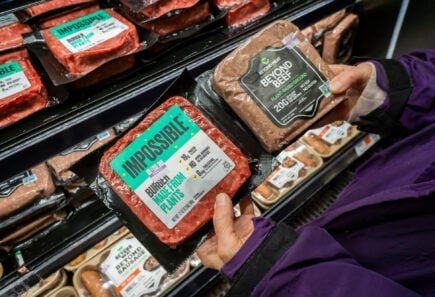
Retail trends and opportunities for plant-based products
Our resources can help you develop successful retail strategies for positioning, merchandising, and marketing plant-based products.
The rise of plant-based meat, eggs, and dairy at retail
In 2022, more than 450 plant-based products hit U.S. retail shelves. Plant-based foods provide an opportunity for retailers to attract high-value consumers.
High-value consumers
Shoppers purchasing plant-based products spend 61% more than the average shopper, according to SPINS data. Retailers will want to provide an array of great-tasting plant-based products to keep these valuable customers in their stores. This will also attract new customers looking for a broad selection of products. No retailer wants to lose these high-value consumers to competitors who have better plant-based assortments.
Target consumers: omnivores and flexitarians
Mainstream consumer segments—traditional meat eaters and flexitarians—are seeking more plant-based products. 95 percent of those who purchase plant-based meat in America also purchase conventional meat products. And 39% of Americans are actively trying to incorporate more plant-based foods into their diets. Meanwhile, 60% of consumers want to reduce their meat consumption.
For more about target consumer groups—from the demographics of early adopters like flexitarians, Millennials, and Gen Z to mainstream consumers—please see our consumer insights resources.
Product assortment & private label product development
Retailers who want to capitalize on plant-based products can start by stocking a wide assortment of plant-based meat, egg, and dairy products across categories. Retailers can also consider developing compelling private-label products, prioritized by the size, growth, and household penetration of the respective plant-based and animal-based categories. Furthermore, retailers can give customers a chance to sample professionally prepared plant-based products by adding them to foodservice offerings and prepared foods.
Download our Good Food Retail Report to see our 2020 benchmarking of the top 15 U.S. retailers on their product offerings across plant-based meat, egg, and dairy categories, including own-brand products.
Merchandising tactics and the future of the meat department
By merchandising plant-based meat, eggs, and dairy alongside their conventional counterparts, retailers can make plant-based options more accessible to the many shoppers who purchase both plant-based and conventional meat. Along with shelf tags, retailers can also leverage “plant-based” aisle signage to communicate store location and product features to customers. Finally, retailers can showcase plant-based categories in endcaps and special displays, especially alongside analogous animal products.
View our guide on how to increase sales with effective merchandising tactics.
Marketing and promotions strategies
Retailers can successfully market plant-based proteins by upping the indulgence factor and featuring tasty plant-based options as alternatives to animal-based options. Retailers can appeal to more customers by using inclusive terms, such as “plant-based” and “plant-protein,” instead of limiting identity-based terms, such as “vegan” or “vegetarian.” Retailers can leverage existing wellness and nutrition programs, as well as seasonal campaigns, and offer an in-store demo program to increase category exposure. New cross-category plant-based themed promotions are another great way to appeal to customers.
Learn more about marketing and promoting plant-based foods.
Activity from major food industry players
Large meat and food companies are taking notice of plant-based products’ consumer and supply chain benefits. Every one of the top five consumer-packaged goods (CPG) companies and top five meat companies (by revenue) in the U.S. is involved in the plant-based industry through either investment, acquisition, partnership, or product line.

Good Food Retail Report
Discover plant-based sales strategies and see how the top 15 U.S. grocery retailers rate on their plant-based assortment, merchandising, and marketing.
Strategies and analyses
From retail sales data to consumer research to marketing and merchandising guides, our resources showcase strategies and case studies in leveraging plant-based meat, egg, and dairy products to grow category and total store sales.
Page
Plant-based retail market overview
Explore sales data for plant-based meat, egg, and dairy products in the U.S. retail market. Find key category insights, size, sales growth, and purchase dynamics for the plant-based industry.
Retail strategies webinar
Get a closer look at which marketing and merchandising strategies are winning, with a special guest from Whole Foods Market.
Our experts

Abby Sewell
CORPORATE ENGAGEMENT MANAGER
Abby serves as GFI’s Corporate Engagement Manager, supporting food manufacturers and other food companies upstream to inspire and accelerate their shift toward alternative protein.
Areas of expertise: CPG marketing, consumer insights, brand strategy, strategic partnerships, social impact

Jody Kirchner
ASSOCIATE DIRECTOR OF MARKET INSIGHTS
Jody Kirchner leads GFI’s market and consumer insights team, delivering data-driven analysis to educate industry leaders and key stakeholders on the opportunities around alternative proteins.
Areas of expertise: consumer insights, market research & analysis, growth strategy, innovation, food industry

Emma Ignaszewski
ASSOCIATE VICE PRESIDENT OF CORPORATE ENGAGEMENT
Emma Ignaszewski oversees the corporate engagement team’s direct outreach group and provides guidance to CE’s operations and support functions. Her work helps to ensure the seamless execution of GFI’s corporate strategy and stakeholder engagement initiatives.
The CE team conducts research and share insights to educate the public on alternative proteins and champion their adoption by the food industry, including manufacturers, retailers, restaurants, investors, and more. By 2050, the global demand for meat is projected to rise significantly. By reimagining how meat is made, we can meet consumers where they are. Our work makes it possible for alternative proteins to increasingly compete with conventional meat, seafood, eggs, and dairy on the key drivers of consumer choice: taste, price, and convenience. We analyze the market, uncover consumer insights, identify AP white spaces and opportunities, and build the community.
Areas of expertise: alternative protein industry landscape, strategic corporate engagement, market insights and consumer research, marketing & communications, alt protein sustainability & climate impacts.

Caroline Bushnell
SENIOR VICE PRESIDENT, CORPORATE ENGAGEMENT
Caroline Bushnell leads GFI’s Corporate Engagement team in their work with companies and investors around the world to accelerate the alternative protein industry.
Areas of expertise: food industry, alternative protein ecosystem, market trends, consumer insights, CPG marketing, emerging industry opportunities.





